
13 minute read
O’BRIEN FARMS’ LEGACY
Kathy served as the National Limousin queen in 1973. At the time, Don O’Brien was a member of the NALF board, so Kathy was able to travel with her father to shows and sales.
“It was really something special,” Kathy remembered. “Not only was I able to promote the breed I grew up in, I was able to spend time with Dad while doing it.”
Advertisement
While Kristy Sanders, Kathy’s oldest daughter, served on the North American Limousin Junior Association (NALJA) board of directors, Don O’Brien still held a place on the NALF board.
“I remember how much he valued the junior board,” Kristy said. “There was a seamlessness between his respect for the juniors and how that translated to the NALF board. Our input was always taken into consideration.”

Kristy said she believes Don’s insistence to listen to feedback is part of the reason her grandfather is remembered as so instrumental in the growth and development of the Limousin breed.
The O’Brien family has impacted the breed so significantly, the most prestigious award given at the National Junior Limousin Show & Congress, the Dick O’Brien Memorial Herdsman award, bears the name of Don’s third eldest son.
Of Don O’Brien’s eight children, all played a part in the success of O’Brien Farms, Kathy said, even though not all eight showed cattle.

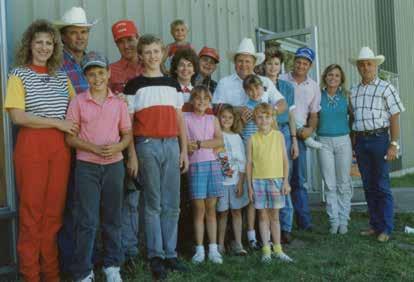

Marsha Douglas and Kathy Brooks standing with Don O’Brien in 1998 when he was presented the Honorary NALJA Membership from George Hubbard.
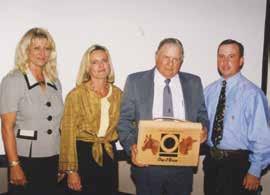

David, Don and Dick O’Brien at a Limousin sale in 1986. Don O’Brien stands with buyer Kody Collins and son Jason O’Brien after one of their production sales.
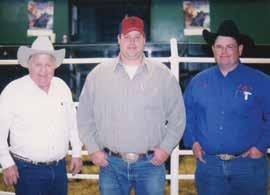
continued from page 59
Don’s oldest daughter, Marsha, and son-in-law, Jary Douglas, managed the family program for a time. Their three children, Lisa, Levi and Brandon, all spent their fair share of time on the end of a show halter winning many banners for both their cattle and showmanship skills.
Another of Don’s sons, John, served as the president of the Missouri Limousin Association.
Youngest son Jason currently manages the O’Brien operation; his children were active in the breed in their youth. A half-century later, Don’s affinity for Limousin cattle has been passed to the fourth generation through his youngest daughter Kathy and her family.
“Bruce [Brooks] and I met while he was managing an early production sale with Ken Holloway of American Cattle Services,” Kathy said. “We got married in 1977.”
Since then, Colonel Brooks has cried hundreds of Limousin bull and female sales. He and Kathy have crisscrossed the country actively marketing Limousin genetics, but more importantly, assisting their many Limousin friends and clients on their most important day of the year.


WZRK GHANDI 3018G 2/15/19 • Black/Het Polled • Purebred CELL Envision x WZRK Miss Tuffenuff 3018A CE: 8 BW: 1.4 WW: 88 YW: 142 MK: 17 SC: 1.0 DC: 20 YG: -.61 RE: 1.36 MB: -.11 $MI: 58
Behind every great bull is a great cow and GHANDI is no exception. His dam is one of the premier donors in the storied Wieczorek program. Study this polled, purebred herd bull prospect that boasts a fresh pedigree and the stoutness every cattlemen demands. He recorded a 119 WW ratio and ranks in the top 10% or better for 10 relevant traits. We are proud to have this rugged designed, muscular, good footed herd sire anchoring our program. The Future Depends On What We Do In The Present. Contact Owners Today for Semen.
• APRIL 2020 MARK & SHARILYN WILLETTE 20061 450th Ave. Delavan, MN 56023 Mark 605/695-3129 - Sharilyn 605/695-5344 luralimousin@gmail.com www.luralimousin.com
All the while, the Brooks’ maintained a healthy herd of Limousin cattle at home. Their daughters, Kristy and Amy, showed primarily Limousin heifers and steers growing up. Kristy won the national sweepstakes award four years running, from 1992-1995. And both sisters were dominant forces both in the show ring and in the satellite events.
“My whole life was the Limousin breed,” Kristy said. “It was my dad’s living, my mom’s history, so it was very natural for me to be involved on all levels.”
The Brooks family scaled back their purebred operation when Kristy and Amy began college, but they continue to use Limousin genetics to influence their commercial cattle, Bruce said.
Amy has known her husband, Levi London, since they were children. They both showed Limousin cattle. In addition Levi’s father, Jim, has been a commercial user of high-end Limousin bulls for decades. Amy and Levi’s story began when they were stalled across from each other at the Tulsa State Fair and Amy stuck her tongue out at Levi. Their sons, Bentley and Beau, show Limousin cattle, and they have a solid Limousin herd at home, Amy said.
“All the cattle the kids show and raise are registered in their names,” Amy said. “We’re just trying to give them the same foundation for the future our parents did for us.”
Amy said she values the work ethic instilled in her through showing cattle, and has been able to connect with old Limousin friends whose kids are also showing.
“Levi and I both always wanted to raise Limousin cattle,” Amy said. “I feel like I’m home again.”
Kristy’s oldest daughter, Peyton, showed her first Limousin heifer in 2013. Since then, Peyton and her sister Kinley have become active in the Oklahoma Junior Limousin Association (OJLA), both in the
continued on page 62
May 30 • Lebanon, MO
Selling the Right to Flush to the Bull of Your Choice
MKJM Evergreen 703E
12/23/17 • Homo Black • Dbl Polled • 43% Lim-Flex CJLM Blacklist 2802B x CJLM Zonked 338B CE: 12 BW: 0.7 WW: 61 YW: 95 MK: 22 SC: 1.41 DC: 13 YG: -.15 RE: .44 MB: .19 $MI: 57
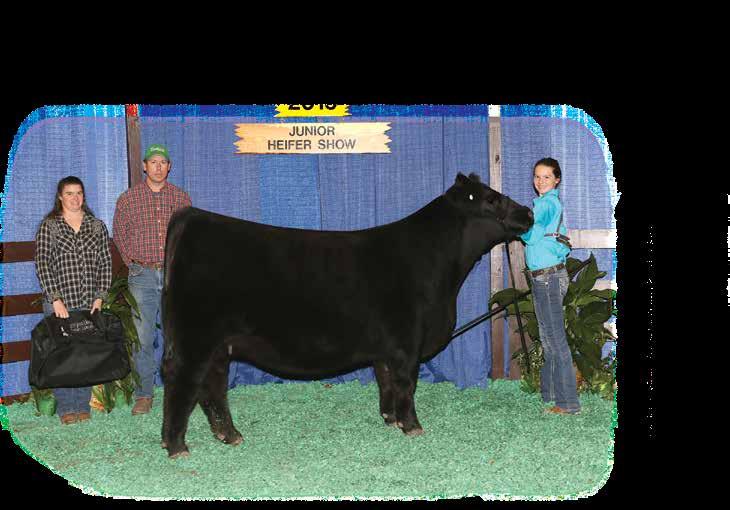

Here is an opportunity to acquire the proven genetics of the grand champion bred-and-owned female at the 2019 NAILE. Evergreen is Massey-bred on both sides of her pedigree and represents three generations of champions bred in our program. Contact us today for additional details on this unique opportunity.
Joey, Melissa, Makayla & Cole Massey 80 Sublimity School Rd., London, KY 40744 cell: 606.682.2126 • josephlmassey@yahoo.com Donnie & Barbara Massey • 606.682.2125 cell


show ring and out. The Collum sisters have both served as OJLA junior ambassadors and Peyton won the national sweepstakes award in 2018. Kinley finished third.
An interesting sidenote: Kristy’s husband, Dustin Sanders, is the son of longtime ACS pilot Ron “Bulldog” Sanders.
Kathy said she’s grateful for the Limousin breed and everything it has given her family.
“It’s been four generations, for sure. There aren’t too many families around that can say that and we’re sure proud we can,” Bruce said.
“Whether he knew it or not, my grandfather started a legacy,” Kristy said. “I always had the desire to continue and build upon that legacy, so when it came to what my daughters were going to show, it wasn’t just about the cattle, but the Limousin family. Why wouldn’t we want our kids to be involved in that?”
One thing is certain. Don O’Brien’s love for the Limousin breed has resulted in a Limousin legacy any family can be proud of. Champion Female, 1976 World Futurity Champion Junior Female, 1995 National Western
Champion Open Female, 1995 National Western Champion Female, 2003 National Junior Show

ABOUT THE AUTHOR: Peyton Haley, from Perry, Oklahoma, graduated from Oklahoma State University in 2019 and is currently pursuing a master’s degree in agricultural communications at OSU. She grew up in the Limousin breed and served as the Oklahoma Junior Limousin Association President.
Grab A Red Bull
JYF Campbell 3C 7/4/15 • Red • Homo Polled • Purebred • B Bar Absolut 3A x CAM Poll Zippity Do Da CE: 4 BW: 4.9 WW: 74 YW: 110 MK: 16 SC: .50 DC: 11 YG: -.79 RE: 1.28 MB: -.52

This homozygous polled, Red purebred is chock-full of performance, meat and muscle and is passing it along to his offspring. His total outcross pedigree makes him usable in just about any breeding scenario. Contact us today for progeny and semen.
JYF Federal 614F 9/14/18 • Red • Homo Polled • Purebred • JYF Chunk 35C x JYF Miss Flintoft 506C CE: 6 BW: 3.3 WW: 78 YW: 127 MK: 18 SC: 1.3 DC: 17 YG: -.81 RE: 1.56 MB: -.42 $MI: 45

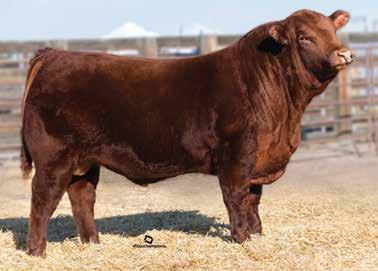
Federal won his class at Agribition and has continued to explode with growth. His yearling index of 116 was number one in his contemporaries. He sported a ribeye index of 111 and a huge yearling scrotal of 41 cm. If you are looking for a bull to beef up a calf crop by adding extra performance, look no further. Contact owners us for your spring semen needs.
BRUCE GUTHMILLER & JANICE GUTHMILLER 1620 37th St. SE - Robinson, ND 58478 - (701) 269-5682 KERMIT & MICHELLE GUTHMILLER Buchanan, North Dakota - (701) 320-5851 Limousin G uthmiller
with these Powerhouse Herd Sires


Add power and style to your next calf crop with one of these powerhouse sires.
AHCC Easy Rider 56% LF - HomoP/HomoB ELMW Alfalfa 103B x AHCC Miss Y Axis C5594 BW: 0.5 WW: 71 YW: 118 MK: 28 CM: 10 SC: 1.2 DC: 11 YG: -.32 CW: 26 RE: .89 MB: .15 $MTI: 60 Top 15% or better for CD, YW, MK, TM, CM SEMEN $40 - Grassroots Genetics


TNGC Empire 736E 50% LF - HomoP/HomoB TMCK Cash Flow 247C x MAGS Beth BW: 2.0 WW: 90 YW: 153 MK: 18 CM: 3 SC: 1.2 DC: 15 YG: -.03 CW: 49 RE: .80 MB: .34 $MTI: 70 Top 15% or better for WW, YW, TM, DC, CW, MB, $MTI Owned with the Empire Syndicate SEMEN $40 - Grassroots Genetics
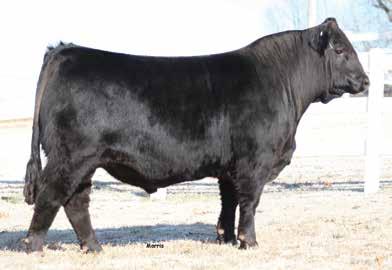

AUTO King David 120E 62% LF - HetP/HomoB AUTO King James 162Z x PBRS Dutches 790X BW: 1.4 WW: 62 YW: 97 MK: 25 CM: 6 SC: 1.2 DC: 10 YG: -.38 RE: .88 MB: -.01 $MTI: 52 Top 15% or better for CW Contact Us for Semen.
GRANT & RACHEL (660) 553-8114 TYE & DEANNA (660) 460-5517 KNOB NOSTER, MO

Study Finds Enterococcus Bacteria Resistance In People Not Related To Antibiotic Use In Cattle

Dr. Tim McAllister, a principal research scientist at the Agriculture and Agri-Food Canada Research and Development Centre in Lethbridge, Alberta, says that, he and his team have found nothing to indicate that antimicrobial resistance (AMR) in beef cattle is being transmitted to humans.
The recent study was published in the academic journal Scientific Reports.
“Antimicrobial resistance is a serious concern for both animal and human health, and part of addressing those concerns is understanding whether there are any linkages between the two,” says Dr. McAllister. “So, at least as far as beef cattle are concerned, this is a significant finding.”
Dr. McAllister is among close to two dozen scientists at five different federal departments and agencies, Alberta Agriculture and Forestry and the University of Calgary involved in a series of interlocking research projects aimed at understanding whether antibiotic use in the beef, pork and poultry industries is increasing the risk of AMR in humans—and if so, what steps can be taken to reduce the risk. The five-year Genomics Research and Development Initiative-AMR project, launched in 2016, is a major component of the Federal Action Plan on Antimicrobial Resistance and Use in Canada. The project also required coordination with feedlot veterinarians, commercial feedlot operators and was partially funded by the Beef Cattle Research Council Cluster.
Focusing on the beef industry, Dr. McAllister collaborates with researchers in other departments in taking a “One Health” approach to the issue.
“Basically, that’s just recognizing there are no borders when it comes to AMR,” says Dr. McAllister. “Bacteria with AMR can be found in humans, in animals, and in the environment, and they may spread from one to the other. That’s why, in our research, we’re looking at bacteria from people being treated for infections in hospitals, from cattle in feedlots, from waterways, from processing plants, sewage plants and elsewhere to see where and what type of AMR exists, and whether we can make any connections from one to the other.”
Using the highly detailed molecular data that can be acquired through whole genome sequencing, Dr. McAllister’s team has
by Agriculture and Agri-Food Canada
determined that the Enterococcus bacteria found in cattle and the Enterococcus that poses a serious threat to human health are actually entirely different species of bacteria.
“We have also discovered that the genes responsible for AMR in the Enterococcus bacteria in humans are associated with antibiotics that are never used in cattle—in other words, it is becoming clear that AMR in cattle is the result of antibiotics used in cattle, and AMR in Enterococcus bacteria found in humans is the result of antibiotics used in humans.”
At the same time, he cautions that you can never say never. “There are billions of cells out there and they are masters of adaptation, so there’s always a chance,” says Dr. McAllister. “We have tried really hard to find the smoking gun—that link of AMR and beef to humans—and we have not. Still, we can’t rule out that there could be a very lucky shot some time in the future. The chances of that happening are very, very low, but they’re not zero.”
Industry welcomes “important step forward”
Genomics research funded through the Genomics Research and Development Initiative and the Beef Cattle Research Council has yet to find any evidence that antimicrobial resistance in beef cattle is being transmitted to humans. At the Beef Cattle Research Council, Science Director Dr. Reynold Bergen says Dr. McAllister’s research represents an important contribution to the development of science-based policy and regulations on the use of antimicrobials in food production. “AMR is a major concern for people and for the beef industry, and something the industry has been researching for more than 20 years,” says Dr. Bergen. “We need antimicrobials to continue to work in people when they get sick, and we need them to work in cattle when they get sick. Dr. McAllister’s research is an important step forward— with no evidence that AMR is being transferred from cattle to people, or vice versa, we can bring new focus to our research, based on the understanding that, although we must continue to use antimicrobials responsibly in both human medicine and cattle production, AMR in humans and AMR in cattle are separate issues.”










